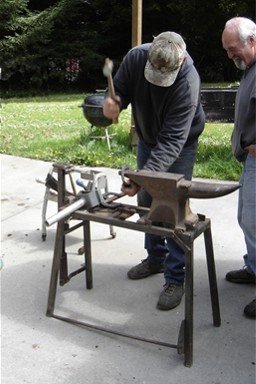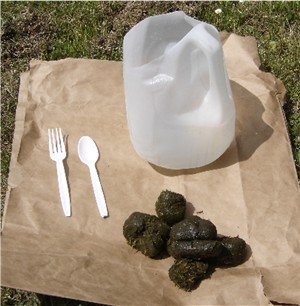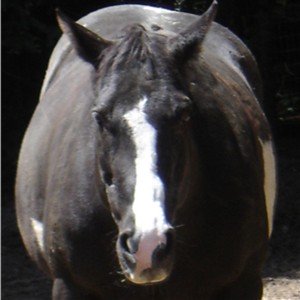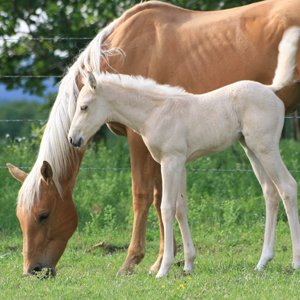Navicular Disease: Treatment and Prevention
Know the Signs of Navicular
Navicular disease is a bone and tissue disorder that occurs in the front hooves of horses. The navicular bone is a tiny bone in the foot that sits just under the deep flexor tendon, next to the coffin and lower pastern bones. When the navicular bone and surrounding tissues become aggravated, it is called navicular syndrome.
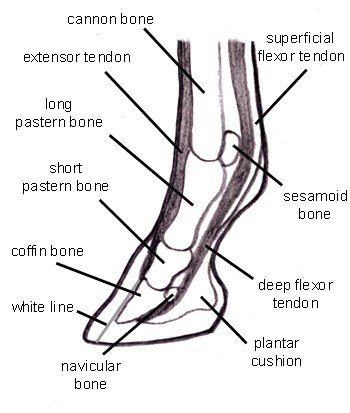
Signs of Navicular Syndrome
- Poor performance
- Shoe wear at the toe
- The horse steps down toe first in an attempt to relieve pressure on the heels
- Painful heels
- Shows pain when pressure is applied to the frog
- Shifts his weight back and forth constantly between the two front feet
- Shows intermittent lameness in early stages
- Heels of the hoof wall begin to contract
- Lameness in both front feet
- Stumbles frequently and has shortened stride with choppy gait
Causes of Navicular
Disease:
Poor Shoeing + Strenuous Work
- Toes too long
- Heels too short
- Hoof uneven – one side of hoof longer than the other
- Hoof not parallel to pastern
- Too long in between shoeing and trimmings
- Allowing too much sole to build up under the toe
- Repetitive strain on flexor tendons
There are two lines of thought about navicular disease. One is that the cause of navicular is unknown and the disease itself is incurable with a poor outcome.
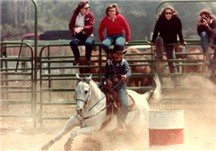
More recent findings show strong evidence as to the causes and successful management of navicular. I like the second train of thought better, don’t you?
Veterinarian Douglas Novick, suggests that navicular disease is caused by a combination of poor shoeing and strenuous work. In his work, he has found a common pattern among patients suffering from navicular. Many suffer from poorly balanced hoof trimming, improper hoof alignment and a strenuous work load; like cattle working, jumping and eventing.
Of course Dr. Novick's finding do not rule out conformation and hereditary factors.
This is worse than having your truck tires out of alignment. Imagine what it does to your horses bones, ligaments and feet......holy cow!
Treatments for Navicular Disease
- Rest
- Corrective shoeing
- Physical therapy
- Nerve blocks
- Surgery
- Maintain proper hoof balance
Horses with navicular respond to corrective shoeing that both allow the contracted heels to grow back to their healthy position and correct all angles of the hoof. This takes time as the hoof grows about ½" per month.
It is extremely important that an experienced farrier, working closely with your veterinarian, do the job. All hoof angles must be corrected over time as the hoof grows. This usually requires special shoes and pads during this critical time.
An 'Egg bar' style horse shoe is often used to offer support to the plantar cushion and take weight off the heel. Wedge pads are used to relieve tension on the tendons and elevate the heels.
Housing your horse on sand will help alleviate some of the pain and help support your horses weight in all the right places during healing. Just be sure you're not feeding him off sand to avoid sand colic. Soft footing like rubber mats and deep stall bedding are also helpful.
Other treatments consist of a rest period followed by physical therapy exercise, nerve blocking shots and surgery. Surgery consists of cutting the nerves to relieve pain. Sometimes the nerves grow back. These nerve blocking procedures relieve pain, but do not prevent navicular bone degeneration.
Extracorporeal Shock wave therapy and acupuncture are non evasive options, but are controversial as to the effectiveness.
Preventing Navicular Disease
The take away lesson here, is to make sure that your horses are receiving proper hoof care from a well trained farrier. They are well worth the money!
Old fashioned common sense suggests that horses worked strenuously have their legs and feet inspected for signs of heat and stress and have the area iced down too reduce swelling of the surrounding tissues.
If in doubt about the quality of your farrier or the health of your horses’ feet….have your vet take a look, because prevention really is the best medicine.
More Equine Topics You May Enjoy
Easy Sand Test
Easy Sand Test - An easy sand test at home is a simple way to find out if your horse has sand in their gut. If your horse tests positive, you can do something about it.
Bumper Stickers

Equine themed bumper stickers perfect for your truck and trailer.
This information is written for the horseman to better understand and cope with the variety of disease and injury that can occur during the course of horse ownership. Always consult with your Veterinarian regarding the care and treatment of your equine.

